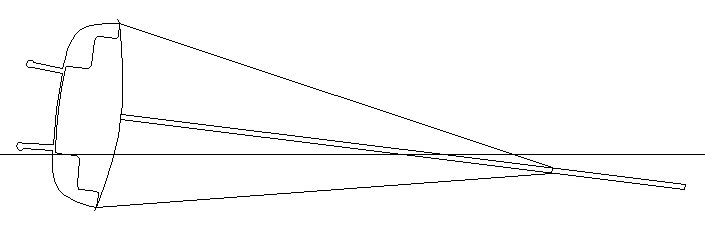A Conceptual Design for CSC's Primary Trainer
By Paul Kamen, August 31 2000
Operational requirements
- Very easy to maintain and repair by inexperienced
volunteers.
- Capable of sailing in shallow water.
- Capable of being righted after capsize by a person
weighing as little as 100 pounds.
- Capacity for four large adults in reasonable comfort.
- Safe for beginners to sail singlehanded in Berkeley summer
conditions.
- Reasonably good performance over a very wide range of wind
conditions.
Some design requirements are conspicuous in their absence,
and these enabled other requirements to be met with relatively
little compromise. These are:
- Pointing ability. CSC's sailing area is mostly crosswind,
and the races have very short windward legs. A tacking angle
as wide as 100 degrees is acceptable.
- Self-bailing. As long as it does not compromise capsize
characteristics, self-bailing is not a high-priority
requirement.
Concept summary:
This design represents an unusual approach to combining
some of the essential features of centerboards and fixed
keels. The keels are shallow and fixed, with ballast bulbs.
But the retractable rudder is large and deep. The rig is
centered further aft than usual to take advantage of the
rudder's ability to generate side force more efficiently than
the shallow keels.
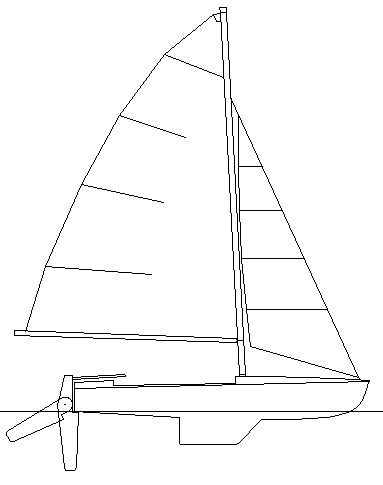
The design rational:
The high live-load capacity and light-skipper self-rescuing
requirements work against each other. They can only be met
simultaneously by a design that has some ballast at the end of
a fin. This can be achieved with a small amount of ballast at
the end of a deep centerboard, but it still leaves the boat
vulnerable when the board is up. It also adds considerable
complication, especially the gear required to raise and lower
a ballasted board. The easy repair and maintenance
requirements call for an easily removable deck, and this is
also complicated by a centerboard case.
These constraints suggest fixed ballast. But instead of a
single ballast keel, this design uses twin biplane keels. The
twin keels have the following advantages:
- More total area, allowing shallower draft.
- Ease of righting after capsize. Even a non-athletic person
should have little trouble climbing up on the lower keel and
holding on to the upper keel when righting the boat.
- Protection during grounding. In some unintentional
beaching or stranding situations, the twin keels will protect
the hull from major damage.
- Light and efficient structure. Bending from the keels is
passed into the main bulkhead at the forward end of the
cockpit, allowing the bottom structure to be kept light. The
fixed keel design also avoids the loss of torsional stiffness
caused by a long slot for a pivoting centerboard.
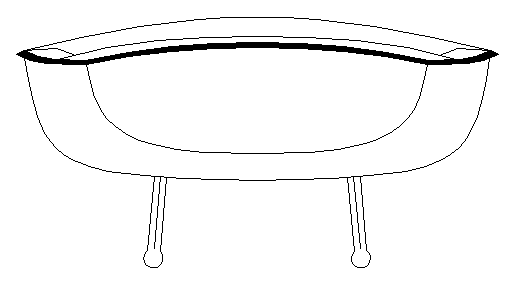
The strategy for recovering some of the efficiency lost due
to the shallow keels is to use a deep and efficient rudder. To
make this work, the rig center of effort is well aft. This
would cause excessive weather helm on a boat with a
conventional rudder, but this rudder can be fine-trimmed to
get just the right balance area to give the helm the right
feel even when it's providing most of the side force.
Note that other designs use the same strategy with success.
The Cal-20 is one of the older examples, and modern sailboards
use single fins for side force resistance.
The low-aspect-ratio rig and long boom help get the sail
forces well aft, and are also consistent with other design
requirements. Because high pointing is not a high priority,
the low rig and higher aerodynamic drag associated with it are
acceptable. The low rig also allows a large enough sail plan
for the boat to feel lively in light air, but still manageable
in heavy air.

The Bird and Golden Gate classes are the best examples of
successful low-aspect rigs. They sail decently in all wind
speeds, and almost never have to reef on SF bay.
Design Specifics:
The CSC-15 is a few inches longer than 15 feet (depending
on bow and stern deck flange details) and six feet wide at the
hull (about two inches wider than a Lido 14). Including the
deck flanges, it will be about 6.5 feet wide. Design keel
draft with a light crew is 20 inches, slightly more with a full
crew.
The mast shown is the existing mast from the current CSC
Lido 14 fleet. The foretriangle base (J measurement) is almost
two feet longer, and the boom is one foot longer. There is
also a lot more roach on the mainsail. The result is that the
rig is considerably more powerful in terms of effective sail
area, but no taller than on the existing boats.
The cockpit seat geometry is similar to the current version
of the Lido 14, but the foot well extends further forward for
a little more space.
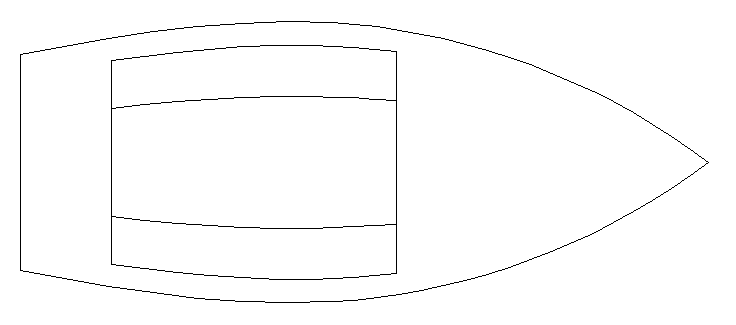
The aft two feet of the cockpit are decked over. This
prevents the common student error of sitting too far aft in
the boat and getting in the way of the tiller. The decked
stern provides a good place to install a large block of
flotation foam. It also helps keep the capsized center of
buoyancy further away from the ballast, increasing the
capsized righting moment.
There is no centerboard case, so crossing the cockpit under
the boom should be easy, especially for large people.
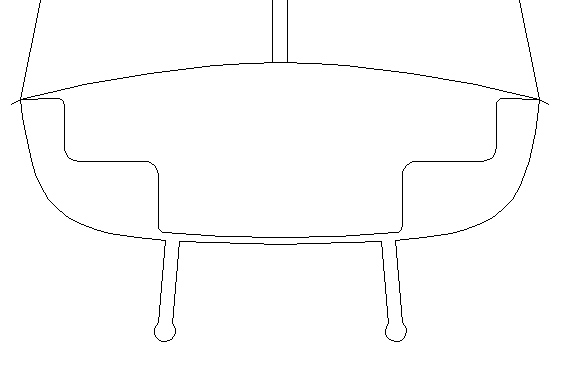
The rudder has to do a lot of work on this boat, and will
have to be well engineered and very robust. Controls for
pivoting the blade up and down will have to be positive and
reliable. The rudder is a potential maintenance problem, but
it can be separated from the boat for overhaul or replacement.
The hull-deck joint involves no adhesives or sealant. The
seal is provided by a double O-ring, shown here as 1/4 inch
diameter circular-section rings of neoprene or other
appropriate O-ring material. The mechanical clamping force is
provided by through-bolts spaced about every six inches along
the rail. An unskilled volunteer with a socket wrench should
be able to remove or replace a deck in about 30 minutes.
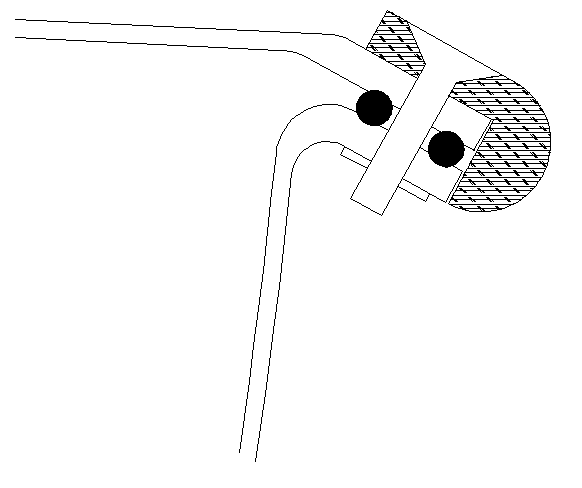
The rub rail is wood, in 12-inch long segments. Each
segment of wood is held in place by two of the through-bolts.
These wood segments of rub rail are designed to be easily
fabricated by anyone with access to a table saw and a file.
They can be cut from 1" x 1-3/4" stock.
The amount of ballast required to achieve hands-off self-righting in most wind conditions is about 150 lb. total,
in the form of a 75 lb. bulb along the bottom of each keel.
This will probably eliminate the need for masthead flotation.
